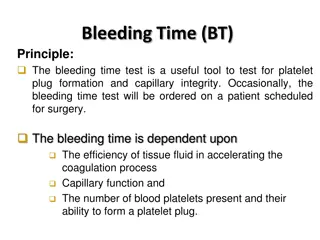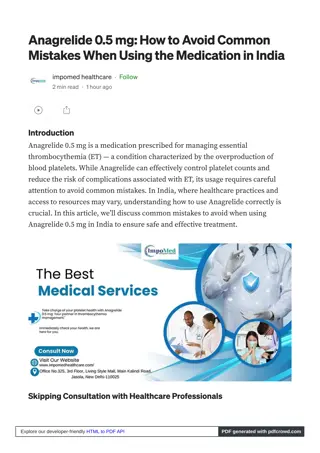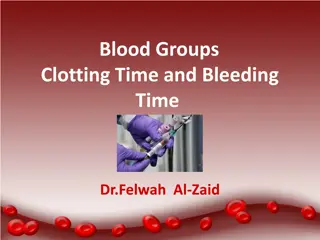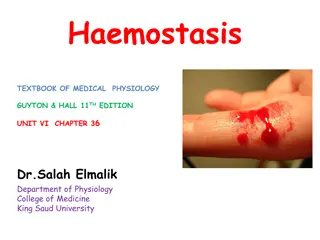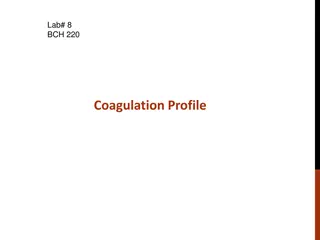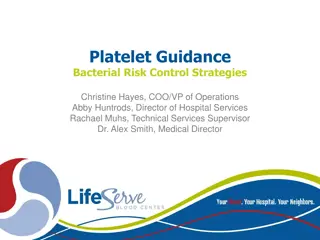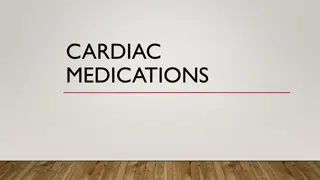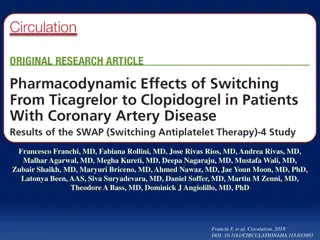Understanding Platelet Count and its Importance in Blood Clotting
Platelets, also known as thrombocytes, play a crucial role in blood clotting. This article explains the structure and lifespan of platelets, the purpose of performing a total platelet count, and the principle of counting platelets using a hemocytometer. It also describes the components used for platelet counting and the Hemocytometer chamber. Understanding platelet count is essential for diagnosing conditions like thrombocytosis and thrombocytopenia.
Download Presentation

Please find below an Image/Link to download the presentation.
The content on the website is provided AS IS for your information and personal use only. It may not be sold, licensed, or shared on other websites without obtaining consent from the author. Download presentation by click this link. If you encounter any issues during the download, it is possible that the publisher has removed the file from their server.
E N D
Presentation Transcript
Dr Egendra Shrestha M V Sc
The Platelets, also known as Thrombocytes, are the Oval, Round or rod-like cells present in the blood that helps mainly in the clotting of blood. On an average, the size of the Platelets is 2 4 m (microns). The mature Thrombocytes are non-nucleated cells with a minute granules present in the cytoplasm and there is no pigment present in Platelets. The Average lifespan of Platelets is 3-10 days. Normally about 150,000 450,000 cells are present per cubic millimeter (mm3) of blood. .
THE AIM / PURPOSE The purpose of performing Total Platelets count is to know whether or not you are suffering from Thrombocytosis a.k.a. Thrombocythemia (i.e. the increase in the no. of Platelets or Thrombocytes to more than 700,000/mm3) or Thrombocytopenia a.k.a. Thrombopenia (i.e. the Decrease in the no. of Platelets / Thrombocytes to less than 50,000/mm3). THE AIM / PURPOSE
PRINCIPLE OF TOTAL PLATELET COUNT USING HEMOCYTOMETER Very large numbers of Platelets/ Thrombocytes are present in the Blood Specimen. Practically, counting this amount of Platelets directly under the microscope is highly impossible. So, the Platelets / Thrombocytes are counted by using a special type of chamber, designed for the counting of blood cells in the specimen, known as Hemocytometer or Neubauer s chamber. For this, the blood specimen is diluted (usually in 1:20 ratio) with the help of Platelet diluting fluid (commonly the Rees Ecker Fluid) which preserve and fix the Platelets / Thrombocytes and stains it. The Rees Ecker fluid is isotonic to the Platelets / Thrombocytes and does not cause any damage to it whereas causes the lysis of red blood cells. After diluting the specimen in appropriate dilutions, the content is charged on Hemocytometer / Neubauer s chamber and the cells are counted in the areas specific for Platelets count. PRINCIPLE OF TOTAL PLATELET COUNT USING HEMOCYTOMETER
COMPONENTS QUANTITY Trisodium Citrate 3.8 gm Brilliant Cresyl Blue 0.1 gm 40% Formalin 0.2 ml Distilled Water 100 ml The Final pH of the solution (at 25 C) varies from 6.8 7.0 which depends on the composition and companies who manufacture it.
Hemocytometer This is a special type of glass chamber that is used for the cell counting, especially for Blood cells. Nowadays, most commonly Improved Neubauer s Chamber is used and in some laboratories, other types of chambers are also employed like Burkers chamber, Levy s chamber and Fusch Rosenthal chamber etc. Hemocytometer / / Neubauer s Neubauer s Chamber Chamber
The Neubauers Chamber has ruled the area of total 9 square mm and the depth is 0.1 mm as when the coverslip is placed on the surface of the counting chamber, the space between the bottom of the cover glass and the base of grooved area measures 0.1 mm in depth. The central 1 square is highly ruled which is divided into 25 squares. Each square of the Central Square is further subdivided into 16 small squares. For Platelets Count, the cells are counted in the 5 squares of the Central square as 4 Corner squares of the Central square (divided into 25 squares) and 1 central square of the Larger Central Square (divided into 25 squares) which is same as for Red Blood Cells.
Each square of the Central Square (divided into 25 squares) contains 16 small squares so the total no. of the area to be counted for Total Platelet Count 16 5 = 80 small squares
Two Method has been developed for the Manual Estimation of Total Platelets / Neubauer s Microdilution Macrodilution Here, I ll explain both the methods but the Microdilution method is not preferred nowadays due to the use of Mouth pipettes. So let s start with Microdilution method and then we ll move to Macrodilution method MICRODILUTION METHOD FOR THE ESTIMATION OF PLATELETS USING HEMOCYTOMETER Materials Required for the Total Platelet Count by Method Blood sample (Capillary blood or EDTA anticoagulated specimen) Platelet diluting fluid (preferably Rees Ecker fluid) Gauze piece or Cotton WBC pipette Hemocytometer a.k.a. Neubauer s Chamber Coverslip Microscope Two Method has been developed for the Manual Estimation of Total Platelets / Thrombocytes Neubauer s chamber Microdilution Method Macrodilution Method Thrombocytes Count Using chamber Method Method Count Using Hemocytometer Hemocytometer / / MICRODILUTION METHOD FOR THE ESTIMATION OF PLATELETS USING HEMOCYTOMETER Materials Required for the Total Platelet Count by Microdilution Method Microdilution
Procedure of the Total Platelet Count by Method specimen and wipe out the pipette externally to avoid false high results. the Rees Ecker Fluid) up to the mark 11. pipette bulb. rotating the pipette (horizontally) between your palms. from its case and clean it using a swab or gauze piece. Similarly, clean out the cover glass and place it over the grooved area of Hemocytometer. Procedure of the Total Platelet Count by Microdilution Method Fill the WBC pipette up to the 0.5 mark with the blood Microdilution Fill the same pipette with the Platelet diluting fluid (i.e. Be cautious that there should be no air bubble in the Mix the Blood and Diluting fluid in the pipette by Take out the Neubauer s chamber / Hemocytometer
Note: thick with very smooth surface and even thickness so that the space between the grooved area of the chamber and cover glass is exactly 0.1 mm. and then discard 1-2 drops from the pipette before charging the chamber. next drop of fluid is in hanging position. edge of the coverslip making an angle of 45 approximately. chamber which occurs by the Capillary action. Do not overcharge the chamber and there should be no air bubble in the Chamber. for 10-15 min so that the cells settle down in the chamber without getting dried & then focus the chamber under the microscope to calculate Platelets. Note: Here a special type of cover glass is used which is 0.4 mm Now, put the WBC pipette, mix the solution present in it again Gently press the rubber tube of the WBC pipette, so that the Touch the Tip of the pipette with the hanging drop against the Allow a small amount of fluid from the pipette to fill into the After charging, Put the charged chamber in a moist condition
MACRODILUTION METHOD FOR THE ESTIMATION OF PLATELETS USING HEMOCYTOMETER Materials Required for the Total Platelet Count by Macrodilution Blood sample (Capillary blood or EDTA anticoagulated specimen) Platelet diluting fluid (preferably Rees Ecker fluid) Hb pipette or Micropipette (0.02 ml or 20 l) Hemocytometer / Neubauer s Chamber Gauze piece or Cotton swab Graduated Pipette (5 ml) Test tubes Cover Slip MACRODILUTION METHOD FOR THE ESTIMATION OF PLATELETS USING HEMOCYTOMETER Materials Required for the Total Platelet Count by Macrodilution Method Method
Procedure of the Total Platelet Count by Method Fluid in a Clean, Dry and Grease free Test tube. Note: can measure 3.98ml or 3980 l of Diluting fluid then take 4 ml of Diluting fluid with the help of 5ml Graduated pipette in the test tube and discard 20 l of fluid using a micropipette or WBC pipette. containing diluting fluid with the help of micropipette or WBC pipette. Hemocytometer / Neubauer s Chamber. from its case and clean it using a swab or gauze piece. Similarly, clean out the cover glass and place it over the grooved area of Hemocytometer. Procedure of the Total Platelet Count by Macrodilution Method Take 3.98 ml of Platelet diluting fluid i.e. Rees Ecker Macrodilution Note: If you don t have variable pipette in the lab which Now add 0.02 ml or 20 l of Blood Specimen to the tube Mix well for few minutes and ready your Take out the Neubauer s chamber / Hemocytometer
Note: is 0.4 mm thick with very smooth surface and even thickness so that the space between the grooved area of the chamber and cover glass is exactly 0.1 mm. Diluted Specimen, mix the solution well and then discard 1-2 drops from the pipette before charging the chamber. so that the next drop of fluid is in hanging position. against the edge of the coverslip making an angle of 45 approximately. fill into the chamber which occurs by the Capillary action. Do not overcharge the chamber and there should be no air bubble in the Chamber. Note: Here a special type of cover glass is used which Now, take out the WBC pipette and fill it with the Gently press the rubber tube of the WBC pipette, Touch the Tip of the pipette with the hanging drop Allow a small amount of fluid from the pipette to
Using Micropipette instead of WBC pipette for charging the pipette for charging the Hemocytometer. So, with a micropipette, carefully draw up around 20 l of the diluted specimen. Press the knob of the pipette to make a hanging drop at the tip of the micropipette. of the cover glass and if required slowly expel the more liquid until the counting chamber is full. This process occurs by Capillary action, but care should be taken not to overfill the chamber. A volume of 10ml is sufficient to fill out the one counting chamber. condition for 10-15 min so that the cells settle down in the chamber without getting dried & then focus the chamber under the microscope to calculate Platelets. Using Micropipette instead of WBC pipette for charging the Hemocytometer You can also use a micropipette instead of WBC Hemocytometer Now gently place the pipette tip against the edge After charging, Put the charged chamber in a moist
CALCULATIONS FOR THE TOTAL PLATELET COUNT USING HEMOCYTOMETER the No. of Platelets in 5 squares of the central square. Let s consider it as N no. of cells. product of Area and depth of the Hemocytometer / Neubauer s chamber. 25 parts so the area is 25 squares = 1 sq. mm squares. So the Area of 5 small squares is 5/25 i.e. 1/5 described above in a short description of Hemocytometer. CALCULATIONS FOR THE TOTAL PLATELET COUNT USING HEMOCYTOMETER After counting the cells under the microscope, we know Now, the volume of the fluid inside the chamber is the The central area is the 1 sq. mm which is divided into Out of these 25 squares, the Platelets are counted in 5 The depth of the Hemocytometer is 0.1 mm as
COUNTING THE PLATELETS / THROMBOCYTES UNDER THE MICROSCOPE lens and then Count the Platelets in 5 small squares of the central square as described above, using the 40x Objective lens. COUNTING THE PLATELETS / THROMBOCYTES UNDER THE MICROSCOPE Focus the ruling using the 10x Objective
and lower lines of the 5 small squares but not the opposite line. In case of marginal cells, count the cells on L line that is either on Right and Lower lines or Left and Upper lines. Count the cells which are lying on the right
Now Apply the Following formula to get the Total Platelets Count Total Platelets Count = N Dilution / Area Depth N 20 / (1/5 0.1) Total Platelet count = N 1000 / mm3 Using the Above formula we can calculate the Total No. of Platelets / Specimen. NORMAL VALUES OF PLATELETS / THROMBOCYTES Normally about 150,000 to 450,000 platelets are present in Healthy individuals. These Values show variations in various physiological and Pathological Conditions. Using the Above formula we can calculate the Total No. of Platelets / Thrombocytes Specimen. NORMAL VALUES OF PLATELETS / THROMBOCYTES Thrombocytes present in the Blood present in the Blood





